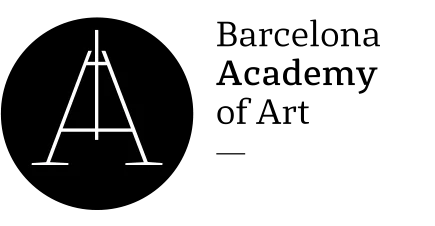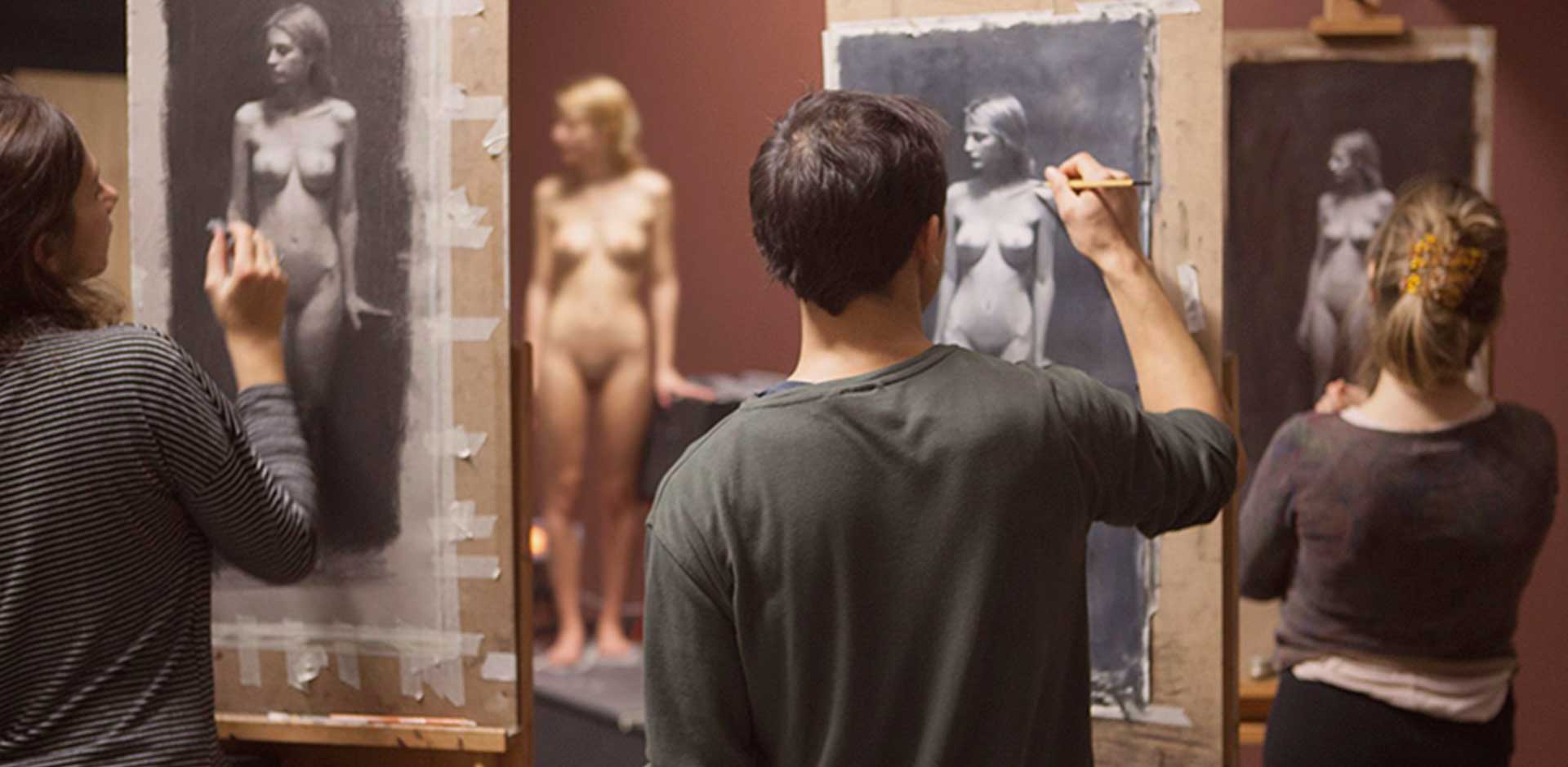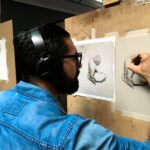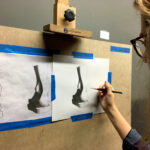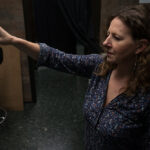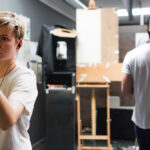Methodology
The Barcelona Academy of Art is an innovative and inclusive school that inherits its methodologies from the classical tradition, using tools and approaches from various countries and different academies of the 19th century to allow its students to develop their own artistic language starting from a solid artistic base. and technique.
Through its programs and following a comprehensive and complete training system, the BAA teaches different methods of observation to guarantee the learning of all the plastic concepts, techniques, systems and resources necessary for the student to develop their personal artistic expression. , both in style and conceptually.
- The Sight-size Method
- The Comparative Method
- The Approaches: Constructive, Light and Form, Visual Impression
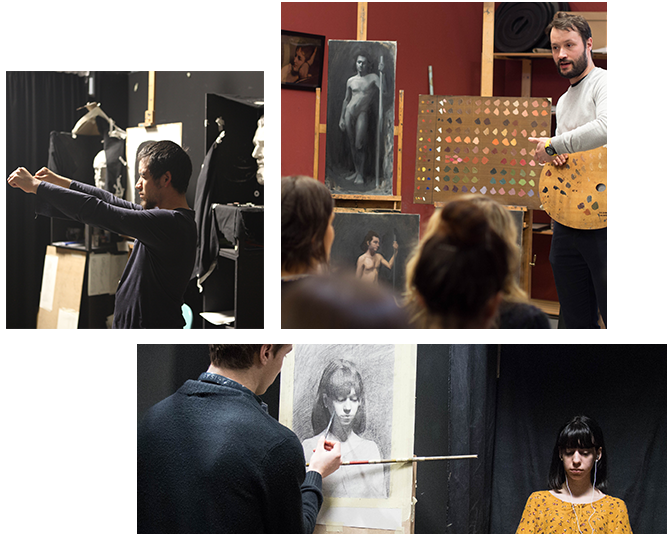
How it works?
Every day, students receive guidance from a different teacher who approaches each workspace and offers individual feedback on the exercise the student is working on. This is what we call a joint critique, always aimed at helping the student assimilate the concepts being worked on, with multiple points of focus in each phase of their learning, to optimally correct, modify, or improve all aspects suggested by the tutor.
The coordinated joint critique on the different projects of the student, facilitated by comments from different teachers, deepens the learning process. Each teacher focuses on different aspects according to their specialty. At the end of each trimester, students receive an individual and personalized overall evaluation involving all their teachers. This evaluation covers five general areas: attendance, performance, effort, attitude, and progress. From these, a final average grade is obtained.
At the Barcelona Academy of Art, each program (Full-Time or Part-Time) consists of a syllabus or schedule of predetermined exercises that the student must complete. The methodology involves each student working through the exercises at their own pace, progressively advancing through the course program, increasing the difficulty and complexity of the exercises over time.
Teachers help students overcome program challenges, and with their consistent effort and hard work, results show up quickly.
The BAA: a school with the spirit of an atelier.
For us, learning from the past is crucial to creating in the present.
The Barcelona Academy of Art has devised an immersive program inherited from the ancient academies of the 19th century, updated and tailored to the world of contemporary art. Each of our program’s students undertakes a series of technical exercises and classical procedures to achieve robust results that resonate in today’s art market.
In French, ‘atelier’ means ‘workshop’ or ‘studio.’ In English, it’s primarily used to refer to a private workshop or the studio of a professional artist where a number of students can work together in producing art pieces under the constant supervision of a master. In these ateliers, students of different levels and diverse cultural backgrounds work together. Each student learns at their own pace while a tutor tailors critiques to the progress of each individual. It’s an incredibly effective way to accelerate the learning process and achieve excellent results in a short period.
The tasks assigned to the students follow the constructive method, meaning each exercise must be fully mastered, and the student must demonstrate mastery of all aspects learned during its completion before advancing to the next level. In the Atelier System, it’s crucial not to rely on photography, always using natural references, be it with models, objects, or landscapes. This principle applies across all disciplines: drawing, painting, sculpture, and digital art.
The Atelier System is a systematic pedagogical method transmitted from tutor to student. It emerged around the 17th century and later became the most widely used method by master painters such as Joshua Reynolds, Thomas Lawrence, or John Singer Sargent. In the revival of the atelier tradition in the 20th century, R.H. Ives Gammell adopted Sight-Size as the foundation of his teaching method. He founded his studio based on the private workshops of masters like Carolus-Duran or Léon Bonnat
The Sight-Size method and the Comparative method:
understanding volume, construction, and form
At the Barcelona Academy of Art, two methods are employed for observing from life, each with three different approaches. Each of these methods carries advantages over the others, beneficial for fostering a deep, comprehensive learning experience adaptable to the individual styles and interests of each student. Therefore, the BAA integrates the Sight-Size Method with the Comparative Method in its curriculum, incorporating the following approaches: constructive, light and form, or impressionist. The combination of these three concepts enhances multiple significant aspects in each student’s work.
The Sight-Size method.
The Sight-Size method is an instructional approach based on achieving drawing accuracy through a direct 1:1 scale comparison between the model and the artwork. Translated, the term means “observation of size,” signifying the study and intention to respect the dimensions of the observed object. The purpose of this method is to train the eye to perceive the differences between the model and its representation without relying on external measuring tools.
The method requires students to complete each task until approved by the instructor before progressing to the next (constructive learning).
The Sight-Size method enables the creation of lifelike images with a unique sensitivity true to life, proving particularly useful in portraying portraits and figurative artworks.
The Comparative method
The Comparative method enables the student to draw, paint, or sculpt an object or figure at any scale, fostering a more constructive and liberating perception compared to the Sight-Size method. It is the most common method among artists and requires the use of external measuring elements.
Thanks to the combination of both methods, the student learns to become more demanding and analytical with what they observe, developing their perception to draw, paint, or sculpt in a more free, organic, and natural manner.
The Approaches: Constructive, Light and Form, Visual Impression
Regardless of the method used for observation, there are different approaches the student must learn to employ, blend, and prioritize according to their interests and the stage of each artwork’s execution.
A constructive vision is necessary for the internal architecture of what’s being depicted, shaping a solid structure and comprehending volume within space. A light and form approach focuses on the accurate modeling of form, internal representation, and the play of light. It also enhances aspects of finish and technical control. Lastly, an impressionist approach aids in understanding the representation of visual impact, chiaroscuro, and the relationship between colors and values of form.
In relation to the different methods, the Sight-Size method is ideal for working towards achieving the visual impression and impressionist effect seen in reality. The Comparative method seeks proportion and shape relationships, understanding their anatomical foundation to accurately represent the subject in space.
